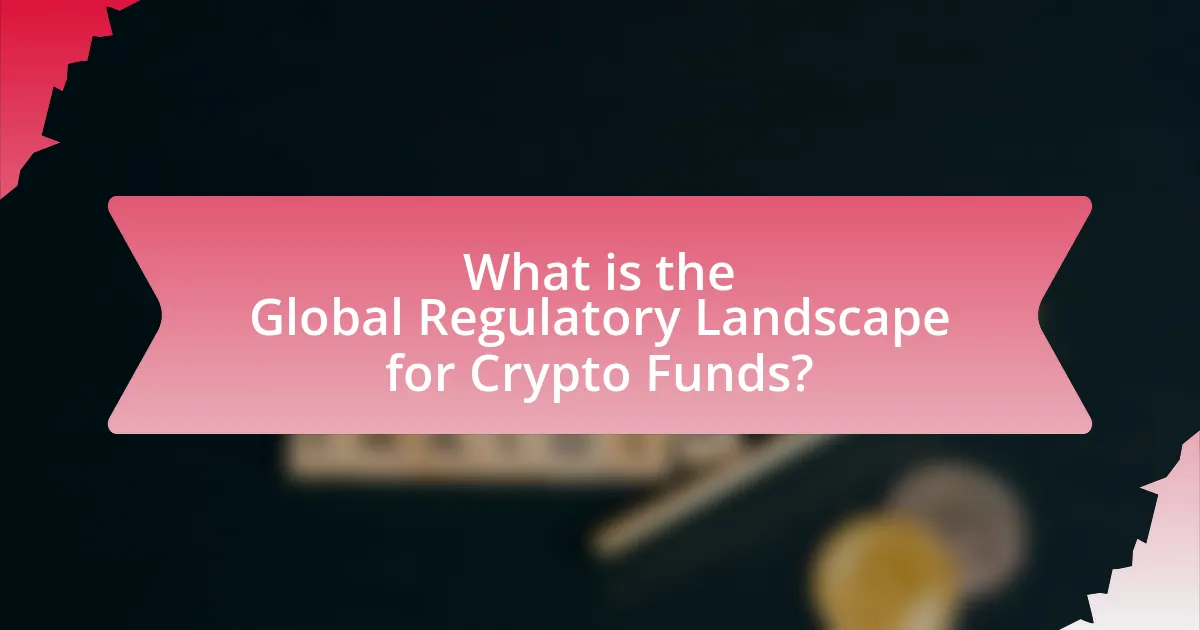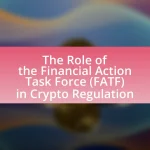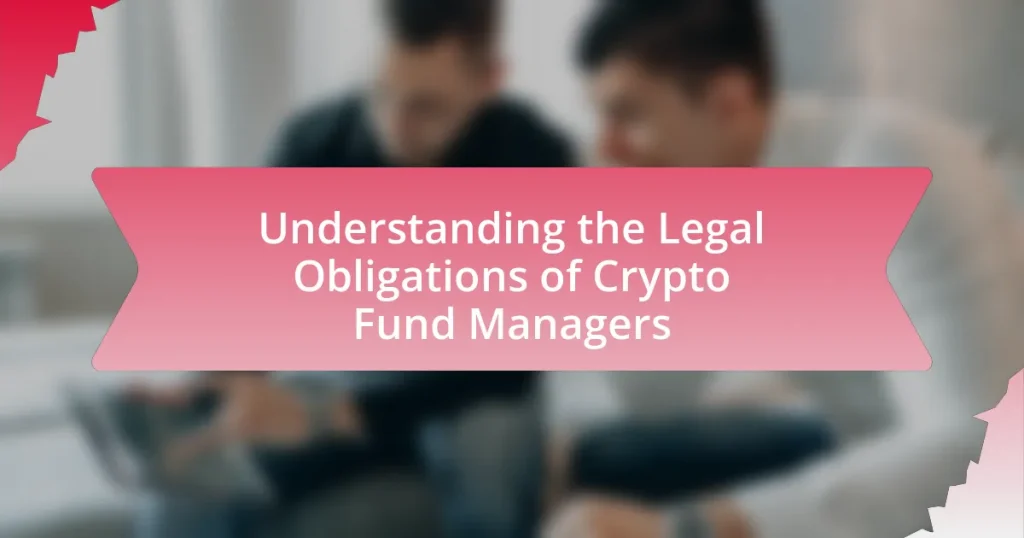The article focuses on the global regulatory landscape for crypto funds, highlighting the diverse regulations that vary across jurisdictions. It examines how different countries, such as the United States, European Union, Switzerland, and China, approach crypto fund regulation, emphasizing the roles of key regulatory bodies like the SEC and CFTC. The article also discusses the implications of regulatory clarity for investors, the risks associated with a lack of regulation, and the challenges faced in harmonizing regulations globally. Additionally, it outlines emerging trends in crypto fund regulation, best practices for compliance, and resources available for navigating the complex regulatory environment.

What is the Global Regulatory Landscape for Crypto Funds?
The global regulatory landscape for crypto funds is characterized by a diverse array of regulations that vary significantly across jurisdictions. Countries like the United States have implemented a patchwork of regulations through agencies such as the SEC and CFTC, focusing on investor protection and market integrity. In contrast, the European Union is working towards a unified regulatory framework with the Markets in Crypto-Assets (MiCA) proposal, aiming to provide clarity and consistency across member states. Additionally, jurisdictions like Singapore and Switzerland have established more favorable regulatory environments to attract crypto investments, emphasizing innovation while ensuring compliance with anti-money laundering (AML) and know-your-customer (KYC) requirements. This regulatory diversity reflects the ongoing evolution of the crypto market and the need for regulatory bodies to adapt to technological advancements and market dynamics.
How do different countries approach the regulation of crypto funds?
Different countries approach the regulation of crypto funds through varying frameworks that reflect their economic priorities and risk tolerance. For instance, the United States employs a fragmented regulatory approach, where agencies like the SEC and CFTC oversee different aspects of crypto assets, leading to a complex compliance landscape. In contrast, countries like Switzerland have established a comprehensive regulatory framework that encourages innovation while ensuring investor protection, exemplified by the Swiss Financial Market Supervisory Authority’s guidelines on Initial Coin Offerings (ICOs). Meanwhile, China has taken a restrictive stance, banning ICOs and cryptocurrency exchanges to mitigate financial risks. These diverse regulatory approaches illustrate how national policies are shaped by local economic conditions, technological advancements, and public sentiment towards cryptocurrencies.
What are the key regulatory bodies involved in crypto fund oversight?
The key regulatory bodies involved in crypto fund oversight include the U.S. Securities and Exchange Commission (SEC), the Commodity Futures Trading Commission (CFTC), and the Financial Conduct Authority (FCA) in the United Kingdom. The SEC regulates securities and has taken action against crypto funds that violate securities laws, while the CFTC oversees derivatives markets, including futures and options on cryptocurrencies. The FCA regulates crypto asset businesses in the UK, ensuring compliance with anti-money laundering regulations. These bodies play crucial roles in establishing frameworks for the operation and oversight of crypto funds, thereby enhancing investor protection and market integrity.
How do regulations vary between developed and developing countries?
Regulations vary significantly between developed and developing countries, primarily due to differences in economic stability, legal frameworks, and technological infrastructure. Developed countries typically have more comprehensive and stringent regulatory frameworks for crypto funds, often established through well-defined legal systems and regulatory bodies, such as the U.S. Securities and Exchange Commission (SEC) in the United States, which enforces strict compliance and investor protection measures. In contrast, developing countries may have less formalized regulations, leading to a more fragmented and inconsistent approach to crypto fund oversight. For instance, while countries like India are beginning to establish regulatory guidelines, others may lack any formal regulations, resulting in a higher risk environment for investors. This disparity is further evidenced by the Global Financial Stability Report, which highlights that developed nations are more likely to implement regulations that address anti-money laundering (AML) and counter-terrorism financing (CTF), whereas developing nations often struggle with enforcement due to limited resources and infrastructure.
Why is understanding the regulatory landscape important for investors?
Understanding the regulatory landscape is crucial for investors because it directly impacts investment risk and compliance. Investors must navigate various regulations that govern financial markets, which can affect the legality and profitability of their investments. For instance, the implementation of the European Union’s Markets in Crypto-Assets Regulation (MiCA) aims to create a unified regulatory framework for crypto assets, influencing how investors engage with these markets. Additionally, non-compliance with regulations can lead to significant financial penalties and legal repercussions, as evidenced by the $1.26 billion in fines imposed by the U.S. Securities and Exchange Commission in 2021 for violations related to securities laws. Therefore, a thorough understanding of the regulatory environment enables investors to make informed decisions, mitigate risks, and capitalize on opportunities within the crypto sector.
What risks do investors face without regulatory clarity?
Investors face significant risks without regulatory clarity, including legal uncertainty, increased volatility, and potential fraud. Legal uncertainty arises when the lack of clear regulations leaves investors unsure about the legality of their investments, which can lead to sudden market shifts or the invalidation of contracts. Increased volatility is common in unregulated markets, as speculative trading can lead to sharp price fluctuations, making it difficult for investors to make informed decisions. Additionally, the absence of regulatory oversight heightens the risk of fraud, as bad actors may exploit the lack of rules to deceive investors, leading to financial losses. Historical instances, such as the collapse of various cryptocurrency exchanges due to regulatory gaps, illustrate these risks, emphasizing the need for a well-defined regulatory framework to protect investors.
How can regulatory compliance enhance investor confidence?
Regulatory compliance enhances investor confidence by ensuring that financial entities adhere to established laws and standards, which mitigates risks associated with fraud and mismanagement. When companies demonstrate compliance with regulations, such as the Anti-Money Laundering (AML) and Know Your Customer (KYC) requirements, they signal to investors that they operate transparently and responsibly. For instance, a study by the CFA Institute found that 78% of investors are more likely to invest in firms that comply with regulatory standards, as compliance reduces uncertainty and fosters trust. This trust is crucial in the volatile environment of crypto funds, where regulatory oversight can protect investors from potential losses and enhance the overall stability of the market.
What are the main challenges in regulating crypto funds globally?
The main challenges in regulating crypto funds globally include the lack of a unified regulatory framework, the rapid pace of technological innovation, and the inherent anonymity of transactions. The absence of a consistent set of regulations across different jurisdictions complicates enforcement and compliance for crypto funds, as seen in the varying approaches taken by countries like the United States and the European Union. Additionally, the fast-evolving nature of blockchain technology often outpaces regulatory efforts, making it difficult for authorities to keep up. Furthermore, the pseudonymous nature of many cryptocurrencies poses significant challenges in tracking illicit activities and ensuring investor protection, as highlighted by the rise in scams and fraud within the crypto space.
How do technological advancements complicate regulation?
Technological advancements complicate regulation by introducing rapid changes in the financial landscape that outpace existing legal frameworks. For instance, the emergence of decentralized finance (DeFi) platforms and cryptocurrencies creates challenges for regulators who must adapt to new technologies that operate outside traditional banking systems. According to a report by the Financial Stability Board, the decentralized nature of these technologies makes it difficult to identify responsible parties for compliance, thereby complicating enforcement efforts. Additionally, the speed of innovation in blockchain technology often leads to regulatory gaps, as laws may not be updated quickly enough to address new risks associated with these advancements.
What are the implications of regulatory arbitrage for crypto funds?
Regulatory arbitrage allows crypto funds to exploit differences in regulations across jurisdictions, leading to potential advantages such as reduced compliance costs and increased operational flexibility. This practice can result in a competitive edge for funds operating in less regulated environments, enabling them to attract more investors seeking favorable conditions. However, it also poses risks, including regulatory scrutiny and potential backlash from authorities aiming to harmonize regulations globally. For instance, the Financial Action Task Force (FATF) has emphasized the need for consistent regulatory frameworks, indicating that jurisdictions allowing regulatory arbitrage may face pressure to tighten their regulations.
How does the regulatory landscape impact the growth of crypto funds?
The regulatory landscape significantly impacts the growth of crypto funds by establishing the legal framework within which these funds operate. Regulations can either facilitate growth by providing clarity and security for investors or hinder it through restrictive measures. For instance, countries with clear regulatory guidelines, such as the United States and Switzerland, have seen a proliferation of crypto funds, as these regulations help to build investor confidence and attract institutional capital. Conversely, regions with ambiguous or overly stringent regulations, like China, have experienced a decline in crypto fund activity, as uncertainty deters investment and innovation. This correlation between regulatory clarity and market growth is evidenced by the increase in crypto fund registrations in jurisdictions that have embraced regulatory frameworks, highlighting the importance of a supportive regulatory environment for the expansion of the crypto fund sector.
What are the emerging trends in crypto fund regulation?
Emerging trends in crypto fund regulation include increased regulatory scrutiny, the establishment of clearer frameworks for compliance, and the integration of anti-money laundering (AML) and know your customer (KYC) requirements. Regulatory bodies worldwide, such as the Financial Action Task Force (FATF) and the U.S. Securities and Exchange Commission (SEC), are actively developing guidelines that mandate transparency and accountability in crypto fund operations. For instance, the SEC has emphasized the need for crypto funds to register as investment companies, which aligns with traditional financial regulations. Additionally, jurisdictions like the European Union are advancing the Markets in Crypto-Assets (MiCA) regulation, aiming to create a comprehensive legal framework for crypto assets, thereby enhancing investor protection and market integrity. These trends reflect a global shift towards harmonizing regulations to mitigate risks associated with crypto investments.
How are regulators adapting to the evolving crypto market?
Regulators are adapting to the evolving crypto market by implementing new frameworks and guidelines that address the unique challenges posed by digital assets. For instance, the Financial Action Task Force (FATF) has introduced guidelines that require countries to regulate cryptocurrency exchanges and ensure compliance with anti-money laundering (AML) standards. Additionally, the U.S. Securities and Exchange Commission (SEC) has increased scrutiny on initial coin offerings (ICOs) and has begun classifying certain cryptocurrencies as securities, thereby subjecting them to existing securities laws. These adaptations reflect a growing recognition of the need for regulatory clarity and consumer protection in the rapidly changing landscape of cryptocurrencies.
What role do international agreements play in harmonizing regulations?
International agreements play a crucial role in harmonizing regulations by establishing common standards and frameworks that facilitate cooperation among countries. These agreements help to reduce regulatory discrepancies, which can create barriers to trade and investment, particularly in sectors like crypto funds where cross-border transactions are prevalent. For instance, the Financial Action Task Force (FATF) sets international standards for combating money laundering and terrorist financing, which member countries adopt to ensure consistency in their regulatory approaches. This alignment not only enhances compliance but also fosters a more stable and predictable environment for businesses operating internationally.
What best practices should crypto fund managers follow to ensure compliance?
Crypto fund managers should implement robust compliance frameworks that include thorough Know Your Customer (KYC) procedures, Anti-Money Laundering (AML) policies, and regular audits. These practices ensure adherence to regulatory requirements and mitigate risks associated with financial crimes. For instance, KYC processes help verify the identity of investors, while AML policies are designed to detect and prevent illicit activities. Regular audits by independent firms can provide transparency and accountability, reinforcing compliance with evolving regulations. According to the Financial Action Task Force (FATF), effective compliance measures are essential for maintaining the integrity of the financial system and fostering trust among investors.
How can crypto funds stay updated on regulatory changes?
Crypto funds can stay updated on regulatory changes by subscribing to industry newsletters, following regulatory bodies on social media, and participating in relevant webinars and conferences. These methods provide timely information directly from authoritative sources, ensuring that funds are aware of the latest developments. For instance, organizations like the Financial Action Task Force (FATF) and the U.S. Securities and Exchange Commission (SEC) regularly publish updates that are crucial for compliance. Additionally, engaging with legal and compliance experts who specialize in cryptocurrency can offer tailored insights into specific regulatory changes affecting the industry.
What resources are available for navigating the regulatory landscape?
Resources available for navigating the regulatory landscape include government websites, legal databases, and industry associations. Government websites, such as those of the Securities and Exchange Commission (SEC) and the Commodity Futures Trading Commission (CFTC), provide official guidelines and updates on regulations affecting crypto funds. Legal databases like Westlaw and LexisNexis offer access to case law, statutes, and regulatory materials relevant to cryptocurrency. Additionally, industry associations such as the Blockchain Association and the Global Digital Finance organization provide resources, best practices, and advocacy for compliance in the crypto sector. These resources are essential for understanding and adhering to the complex regulatory requirements in the crypto landscape.













